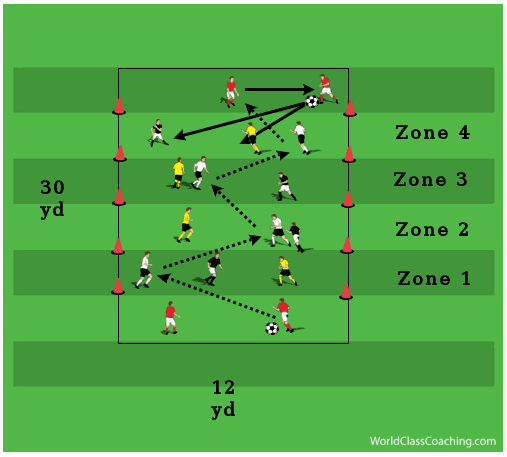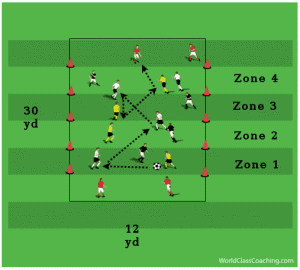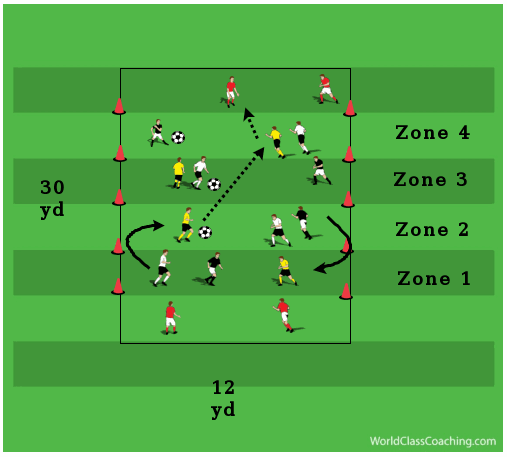By Chris Kouns
USSF A License (USSF Coaching Education Instructor) – NSCAA Premier Diploma (NSCAA Coaching Education Associate Staff Coach) – Head Coach Georgia Gwinnett College Women's Soccer
Activity 1
There are four teams of four players each divided into the following groups. In each end zone there will be two players from one team. Then, the remaining three teams will have one player in each of the four (4) central zones. To begin with there are three balls in play (one for each team with a player in the middle zones) and the goal is for each team to move their ball from one end zone to the other end zone using one and two touch passes. When the ball reaches the end zone then the player receiving it will play it across to their teammate in the end zone and it will be played back into play to go the other direction.
TIME
Typical rotation of teams will happen every two minutes, but, you can adapt to put more / less pressure on the players based on their technical ability and proficiency.
RESTRICTIONS
Players must stay in their zones but they are allowed to move left and right in order to set up passing angles for their teammates. In addition all passes must be made diagonally, not straight ahead, so the movement should also allow you to need no more than one or two touches to play the ball into the next zone.
COACHING POINTS
- Players should move on each pass

To enable them to receive a one or Two touch ball from the player who is getting the pass. It does not matter that they will not be getting the pass because it must go from zone to zone, the important thing is for them to prepare to be an option to receive it. - To help your teammates be able to play the ball one or two touch play the ball to their front foot so they will be able to move into the ball and not have to take an extra touch.
- Early, specific communication from the player in the next zone will help make the connection go more smoothly and quickly.
Activity 2
Using the same setup as the first activity this time the coach should require players in certain zones to swap grids when a ball is played into an end zone. It may be easiest to say that the opposite two grids from the end zone where the ball is played will be the two who switch. (For instance in the diagram below when the ball enters the end zone it is the players in Zones 1 & 2 who will swap places.) This will allow players to begin to get used to the process and expectations.
RESTRICTIONS
You can use just one ball in the activity and then have the coach randomly call out zones to swap. This would probably be for teams with more technically and tactically aware players. It is not recommended that you use three balls if you are going to randomly call out zones to change, but, do so according to the ability of your players. If only using one ball then the end zone team will play the ball to a different team going the other direction than the one that gave them the ball.
COACHING POINTS
- All players must keep their heads on a swivel, taking a peek over their shoulder, to ensure they are awares of balls that might be close to entering the end zone and require movement
- When transitioning from zone to zone make sure you do not turn your back to the ball. Instead, look to allow your hips to run while your shoulders and head maintain contact with the ball.
- If using just one ball players may be allowed to skip zones but the same rules still apply regarding balls be played diagonally and not straight ahead vertically.
- Player movement should come as a result of recognizing both space that was vacated by someone in the other zone as well as what will allow your body to be available for an immediate pass.
Activity 3
This will require the same field set up as the last two activities, but, now there will be a 2 v 1 “numbers up” advantage in each zone. The objective is still to work the ball from one end zone to the other end zone and we are still focused on playing balls on a diagonal plane rather than a vertical plane.
RESTRICTIONS AND SCORING
This activity is essentially a “Make it – Take it” activity, so, if the ball goes from one end zone to the other successfully the team defending does not come out of that role.
If the defending does win the ball they are now joined by the team who did not actually give away possession and the game will continue in either direction they wish to go. The key will be a quick decision to “Secure Possession” by playing an easy pass and then players work off that ball to get it to the end zone.
ADAPTATION – Once players are able to quickly recognize and take advantage of the “Numbers Up” situation then you can advance this set up to an 8 v 4 format with the team off keeping two players in each end zone. If that is the case each team who is in possession (the eight) will get a point every time they work the ball from one end zone to the other. You will want to play for a standard amount of time so that each team will spend the same amount of time in the end zone and have equal opportunity for points.
COACHING POINTS
- 1) In each zone the two players should
 focus on their width, body position, and movement so that they will be able to form a triangle between the ball, their partner in the zone and their partners in the following zone.
focus on their width, body position, and movement so that they will be able to form a triangle between the ball, their partner in the zone and their partners in the following zone. - 2) It is vital that the players do not get into a supporting position too early as that will kill the space. They will want to time their runs so that the defender does not have time to think about who to cover and what space to cut out.
- 3) The quality of passing and receiving skills exhibited by all players must be of the highest standard. Each first touch should be able to either eliminate the defender in their zone or move the ball into a position where the defender cannot get to the ball before it is played on the next touch. When playing a ball it must be at a pace which will allow the player receiving it to play the ball first time, played at an angle away from the defender and into a space where there are multiple options for the receiver.
By Chris Kouns: USSF A License (USSF Coaching Education Instructor) – NSCAA Premier Diploma (NSCAA Coaching Education Associate Staff Coach) – Head Coach Georgia Gwinnet College Women’s Soccer (GA)



